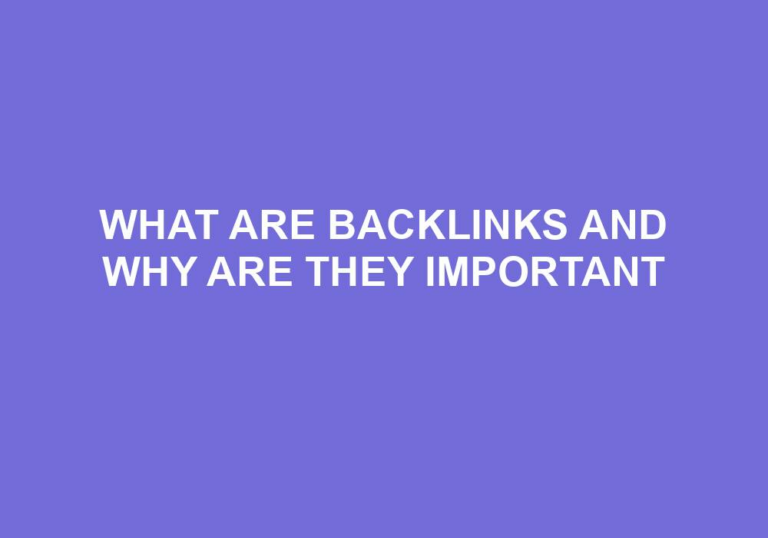Are you a WordPress enthusiast looking to boost your website’s visibility and drive more traffic to your content? Then you’re in the right place! In today’s digital age, backlinks play a crucial role in improving your website’s search engine ranking and overall online presence. Whether you’re a seasoned blogger or just starting out, understanding how to effectively add backlinks in WordPress is essential for success. In this comprehensive guide, we will walk you through the step-by-step process of adding backlinks to your WordPress site, ensuring that you maximize the benefits of this powerful SEO strategy. Get ready to take your website to new heights and watch your organic traffic soar!
When it comes to improving your website’s SEO, backlinks are the secret ingredient that can make all the difference. Backlinks are essentially links from other websites that direct users back to your own site. Not only do they drive traffic to your content, but they also signal to search engines that your website is reputable and trustworthy. In this guide, we will demystify the process of adding backlinks in WordPress, breaking it down into simple and actionable steps. Whether you’re looking to connect with other bloggers, collaborate with influencers, or simply want to strengthen your website’s authority, our easy-to-follow instructions and expert tips will help you navigate the world of backlinking like a pro. So, let’s dive in and unlock the full potential of your WordPress site with the power of backlinks!
To add backlinks in WordPress, follow these steps:
1. Install and activate a backlink plugin like “Yoast SEO” or “Rank Math.”
2. Open the plugin settings and navigate to the “Link” or “Backlink” section.
3. Click on the “Add New” button to create a new backlink.
4. Enter the URL of the website you want to link to and add a relevant anchor text.
5. Save the changes and the backlink will be added to your WordPress website.
- Install and activate a backlink plugin like “Yoast SEO” or “Rank Math.”
- Open the plugin settings and navigate to the “Link” or “Backlink” section.
- Click on the “Add New” button to create a new backlink.
- Enter the URL of the website you want to link to and add a relevant anchor text.
- Save the changes and the backlink will be added to your WordPress website.
How to Add Backlinks in WordPress
Backlinks are an essential part of any successful website. They help to improve your site’s visibility in search engine results and drive more traffic to your pages. If you’re using WordPress to power your website, adding backlinks is a relatively simple process. In this article, we’ll walk you through the steps to add backlinks in WordPress, helping you boost your site’s search engine optimization (SEO) and attract more visitors.
Step 1: Install a Backlink Plugin
The first step to adding backlinks in WordPress is to install a backlink plugin. There are several plugins available that can help you manage and track your backlinks. One popular option is the Yoast SEO plugin, which not only helps with backlinks but also provides a range of other SEO features. To install the Yoast SEO plugin, follow these steps:
1. Log in to your WordPress dashboard.
2. In the left-hand menu, click on “Plugins” and then “Add New”.
3. In the search bar, type “Yoast SEO” and press Enter.
4. Click on the “Install Now” button next to the Yoast SEO plugin.
5. Once the installation is complete, click on the “Activate” button.
Step 2: Set Up Your Backlink Settings
After installing the backlink plugin, you’ll need to configure the settings to ensure your backlinks are working correctly. Here’s how:
1. In your WordPress dashboard, go to “SEO” and click on “Search Appearance”.
2. Click on the “General” tab and then navigate to the “Features” tab.
3. Ensure that the “Advanced settings pages” option is enabled.
4. Click on the “Save Changes” button to apply the settings.
5. Next, click on the “Advanced” tab and then select the “Permalinks” tab.
6. Choose the URL structure that you prefer for your backlinks and click on the “Save Changes” button.
Step 3: Add Backlinks to Your Content
Now that you have the backlink plugin installed and configured, you can start adding backlinks to your content. Follow these steps:
1. Create a new post or edit an existing one.
2. In the post editor, highlight the text that you want to turn into a backlink.
3. Click on the “Insert/Edit Link” button in the toolbar.
4. In the link URL field, enter the URL of the page you want to link to.
5. Optionally, you can add a title for the link in the link title field.
6. Click on the “Apply” button to add the backlink to your content.
7. Repeat these steps for any additional backlinks you want to add.
Step 4: Monitor and Manage Your Backlinks
Once you’ve added backlinks to your WordPress site, it’s important to monitor and manage them regularly. This will help you ensure that the links are still working and that they are contributing to your site’s SEO efforts. Here are a few tips for monitoring and managing your backlinks:
1. Use a backlink monitoring tool to keep track of the performance of your backlinks.
2. Regularly check for broken or outdated backlinks and update them as necessary.
3. Consider reaching out to other website owners to request backlinks to your site.
4. Continuously create high-quality content that attracts natural backlinks.
By following these steps and regularly managing your backlinks, you can improve your site’s SEO and drive more traffic to your WordPress website. Remember, quality backlinks are key, so focus on building relationships with reputable websites and creating valuable content that others will want to link to. Happy backlinking!
Frequently Asked Questions
Here are some commonly asked questions about how to add backlinks in WordPress:
What are backlinks and why are they important for SEO?
Backlinks, also known as inbound links, are hyperlinks from one website to another. They play a crucial role in search engine optimization (SEO) as they indicate to search engines that your website is trustworthy and authoritative. Backlinks can help improve your website’s visibility in search engine results and drive more organic traffic to your site.
When other reputable websites link to your content, it signals to search engines that your website has valuable and relevant information. This can positively impact your website’s ranking in search results, making it easier for users to discover your content.
How can I add backlinks to my WordPress website?
Adding backlinks to your WordPress website is relatively simple. Here’s a step-by-step guide:
1. Identify relevant and reputable websites: Look for websites that are related to your niche or industry and have a good reputation. These are the websites you want to target for backlinking.
2. Reach out to website owners: Once you’ve found potential websites, reach out to their owners or webmasters and propose a collaboration or guest posting opportunity. Offer to provide high-quality content in exchange for a backlink to your website.
3. Create compelling content: To attract backlinks, create valuable and shareable content on your WordPress website. This can include blog posts, infographics, videos, or any other form of content that provides useful information to your target audience.
4. Use plugins: WordPress offers various plugins that can assist in managing and optimizing your backlinks. Plugins like Yoast SEO and Rank Math can provide insights and suggestions for improving your website’s SEO, including backlinking strategies.
Are all backlinks equally valuable?
No, not all backlinks are equally valuable. It’s important to focus on acquiring high-quality backlinks from reputable websites rather than simply accumulating a large number of backlinks. Search engines consider the authority and relevance of the linking website when determining the value of a backlink.
A backlink from a well-established website with a strong domain authority will have a more significant impact on your SEO efforts compared to a backlink from a low-quality or irrelevant website. Quality backlinks are typically obtained from websites that are trusted by search engines and have a good reputation within your industry.
Should I buy backlinks for my WordPress website?
No, buying backlinks is not recommended for your WordPress website. Search engines, such as Google, strictly discourage the practice of purchasing backlinks. Buying backlinks violates their guidelines and can result in penalties, including a drop in search engine rankings or even de-indexing of your website.
Instead of buying backlinks, focus on creating valuable and shareable content that naturally attracts backlinks from reputable sources. Building organic backlinks takes time and effort, but it’s a sustainable and effective strategy for improving your website’s SEO in the long run.
Can I use anchor text for backlinks in WordPress?
Yes, you can use anchor text for backlinks in WordPress. Anchor text is the clickable text within a hyperlink. It plays a role in defining the relevance and context of the linked page. When adding a backlink, you can choose to use relevant anchor text that accurately describes the content of the linked page.
Using descriptive and keyword-rich anchor text can help search engines understand the context of the linked page and improve its visibility in relevant search results. However, it’s crucial to use anchor text sparingly and naturally. Overusing or spamming anchor text can be seen as manipulative by search engines and may result in penalties.
In conclusion, understanding how to add backlinks in WordPress is a crucial skill for any website owner or blogger looking to improve their online visibility. By incorporating high-quality backlinks into your content, you can attract more organic traffic, enhance your website’s authority, and ultimately achieve higher search engine rankings. Remember to focus on relevant and reputable sources when obtaining backlinks, as this will not only benefit your website’s SEO but also provide valuable resources for your readers.
Furthermore, it is important to regularly monitor and update your backlinks to ensure their effectiveness. Keep an eye on broken or outdated links and promptly replace them with new ones to maintain a seamless user experience. By consistently incorporating backlinks into your WordPress website, you can establish a strong online presence, drive more traffic, and ultimately achieve success in the competitive digital landscape. So, take the time to learn and apply the strategies discussed in this guide, and watch as your website’s visibility and credibility soar.





